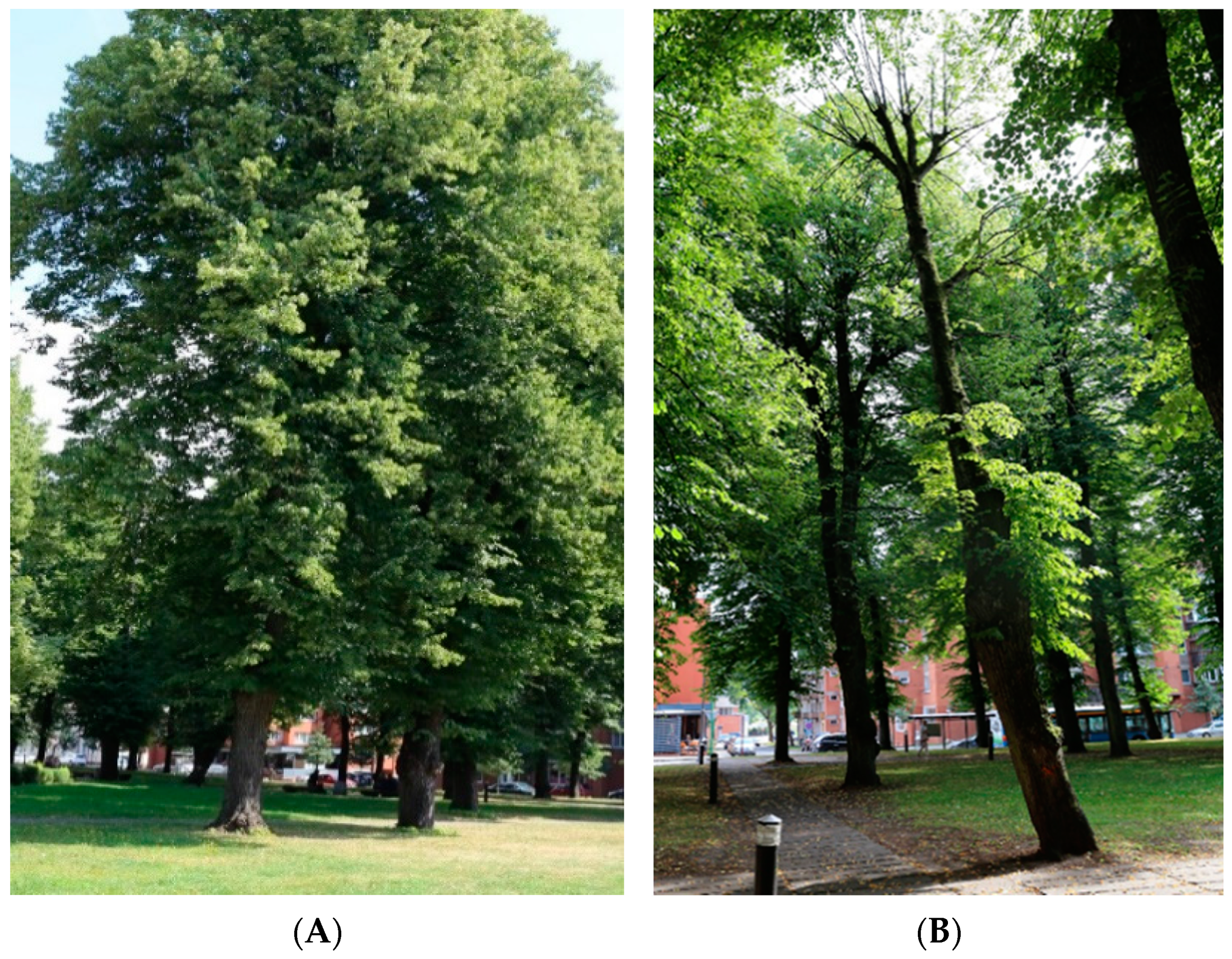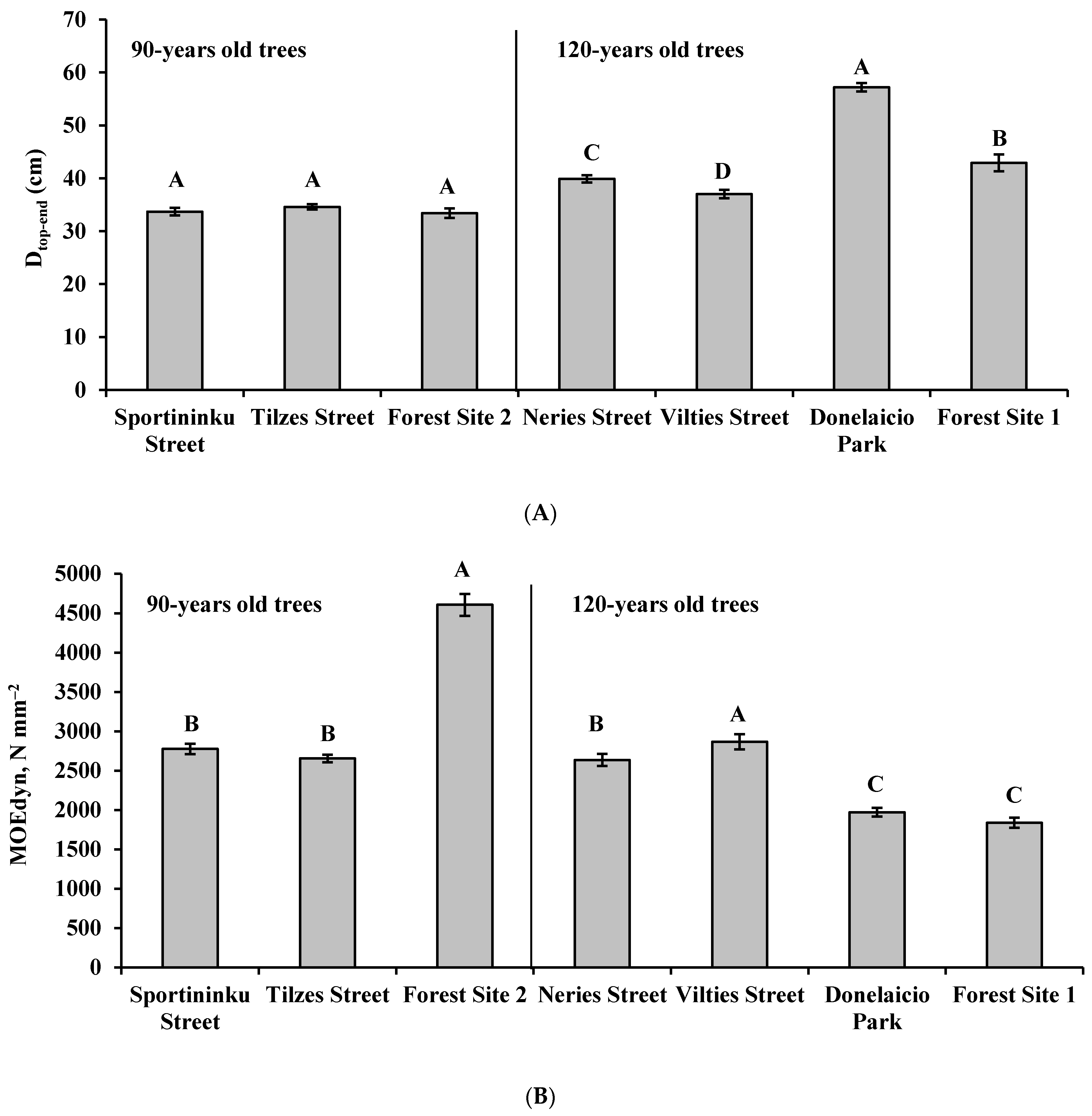The Wood Quality of Small-Leaved Lime (Tilia cordata Mill.) Trees in an Urban Area: A Pilot Study
Abstract
:1. Introduction
2. Materials and Methods
2.1. Site Characteristics
2.2. Tree Health Assessment
2.3. Wood Quality Assessment
2.4. Statistical Analyses
3. Results
3.1. Wood Quality Measurements
3.2. Relations between Wood Quality Parameters
4. Discussion
5. Conclusions
Author Contributions
Funding
Institutional Review Board Statement
Informed Consent Statement
Data Availability Statement
Acknowledgments
Conflicts of Interest
References
- Jaworski, A.; Kołodziej, Z.; Bartkowicz, L. Structure and dynamics of stands of primeval character composed of the little-leaf linden (Tilia cordata Mill.) in the “Las lipowy Obrożyska” reserve (southern Poland). J. For. Sci. 2005, 51, 283–304. [Google Scholar] [CrossRef] [Green Version]
- EUFORGEN. Distribution Map of Lime. Available online: http://www.euforgen.org/species/tilia-cordata/ (accessed on 5 January 2021).
- Radoglou, K.; Dobrowolska, D.; Spyroglou, G.; Nicolescu, V.N. A review on the ecology and silviculture of limes (Tilia cordata Mill., Tilia platyphyllos Scop. and Tilia tomentosa Moench.) in Europe. Die BodenKult 2009, 60, 9–20. [Google Scholar]
- Ellenberg, H.; Leuschner, C. Vegetation Mitteleuropas mit den Alpen, 6th ed.; Ulmer Verlag: Stuttgart, Germany, 2010; p. 1357. [Google Scholar]
- Svejgaard, J.J. EUFORGEN Technical Guidelines for Genetic Conservation and Use for Lime (Tilia spp.); International Plant Genetic Resources Institute: Rome, Italy, 2003; p. 6. [Google Scholar]
- Saebo, A.; Benedikz, T.; Randrup, T.B. Selection of trees for urban forestry in the Nordic countries. Urban. For. Urban. Green. 2003, 2, 101–114. [Google Scholar] [CrossRef] [Green Version]
- Sjoman, H.; Östberg, J.; Bühler, O. Diversity and distribution of the urban tree population in ten major Nordic cities. Urban. For. Urban. Green. 2012, 11, 31–39. [Google Scholar] [CrossRef] [Green Version]
- Moser, A.; Rötzer, T.; Pauleit, S.; Pretzsch, H. Structure and ecosystem services of small-leaved lime (Tilia cordata Mill.) and black locust (Robinia pseudoacacia L.) in urban environments. Urban. For. Urban. Green. 2015, 14, 1110–1121. [Google Scholar] [CrossRef]
- De Jaegere, T.; Hein, S.; Claessens, H. A review of the characteristics of small-leaved lime (Tilia cordata Mill.) and their implications for silviculture in a changing climate. Forests 2016, 7, 56. [Google Scholar] [CrossRef] [Green Version]
- Ministry of Environment, State Forest Service. Lithuanian Statistical Yearbook of Forestry; Dagilius, R., Eigirdas, M., Kuliešis, A., Vižlenskas, D., Eds.; Lutute: Kaunas, Lithuania, 2019; p. 184. ISSN 1648-8008.
- Zeimavicius, K.; Budriunas, A.R. The necessity of street tree assortment alteration in Lithuania. Urban Forestry in the Nordic and Baltic Countries-Urban Forests under Transformation. Raports 2001, 9, 57–60. [Google Scholar]
- Semaškienė, L. Small-Leaved Lime (Tilia Cordata Mill.) in Lithuania: Phenotypical Diversity and Productivity of Modal Stands. Ph.D. Thesis, Lithuanian University of Agriculture, Kaunas, Lithuania, 2006. [Google Scholar]
- Iakovoglou, V.; Thompson, J.; Burras, L.; Kipper, R. Factors related to tree growth across urban-rural gradients in the Midwest, USA. Urban. Ecosyst. 2001, 5, 71–85. [Google Scholar] [CrossRef]
- Morgenroth, J.; Buchan, G.; Scharenbroch, B.C. Belowground effects of porous pavements—Soil moisture and chemical properties. Ecol. Eng. 2013, 51, 221–228. [Google Scholar] [CrossRef]
- Bradshaw, A.; Hunt, B.; Walmsley, T. Trees in the Urban Landscape: Principles and Practice; E. & FN Spoon: London, UK, 1995. [Google Scholar]
- Pauleit, S.; Jones, N.; Garcia-Martin, G.; Garcia-Valdecantos, J.L.; Riviere, L.M.; Vidal-Beaudet, L.; Bodson, M.; Randrup, T.B. Tree establishment practise in towns and cities—Results from a European survey. Urban. For. Urban. Green. 2002, 1, 83–96. [Google Scholar] [CrossRef]
- Dobson, M.C. De-icing Salt Damage to Trees and Shrubs. In Forestry Commission Bulletin; HMSO: London, UK, 1991; p. 101. [Google Scholar]
- Roberts, J.; Jackson, N.; Smith, M. Tree Roots in the Built Environment; TSO: London, UK, 2006. [Google Scholar]
- Vogt, J.; Gillner, S.; Hofmann, M.; Tharang, A.; Dettmann, S.; Gerstenberg, T.; Schmidt, C.; Gebauer, H.; Van de Riet, K.; Berger, U.; et al. Citree: A database supporting tree selection for urban areas in temperate climate. Landsc. Urban. Plan. 2017, 157, 14–25. [Google Scholar] [CrossRef]
- Gilbertson, P.; Bradshaw, A.D. Tree survival in cities: The extent and nature of the problem. Arboric. J. 1985, 9, 131–142. [Google Scholar] [CrossRef]
- Moll, G. The state of our urban forest. Am. For. 1989, 95, 61–64. [Google Scholar]
- Nilsson, K.; Randrup, T.B.; Wandall, B.M. Trees in the Urban Environment. In The Forest Handbook; Evans, J., Ed.; Blackwell Science: Oxford, UK, 2000; Volume 1, pp. 347–361. [Google Scholar]
- Vacek, S.; Prokupkova, A.; Vacek, Z.; Bulušek, D.; Šimunek, V.; Kraliček, I.; Prausova, R.; Hajek, V. Growth response of mixed beech forests to climate change, various management and game pressure in Central Europe. J. For. Sci. 2019, 65, 331–345. [Google Scholar] [CrossRef]
- Helama, S.; Laanelaid, A.; Raisio, J.; Tuomenvirta, H. Mortality of urban pines in Helsinki explored using tree rings and climate records. Trees (Berl. West.) 2011, 26, 353–362. [Google Scholar] [CrossRef]
- Pigott, D. Lime-Trees and Basswoods: A Biological Monograph of the Genus Tilia, 1st ed.; Cambridge University Press: New York, NY, USA, 2012; p. 405. [Google Scholar]
- Rowe, D.B.; Blazich, F.A.; Tilia, L. Linden or basswood. In The Woody Plant. Seed Manual; U.S. Department of Agriculture: Washington, DC, USA, 2008; pp. 113–118. [Google Scholar]
- Popescu, M.C.; Lisa, G.; Froidevaux, J.; Navi, P.; Popescu, C.M. Evaluation of the thermal stability and set recovery of thermo-hydro-mechanically treated lime (Tilia cordata) wood. Wood Sci. Technol. 2014, 48, 85–97. [Google Scholar] [CrossRef]
- Petersen, A.; Eckstein, D.; Liese, W. Holzbiologische Untersuchungen uber den Einfluss von Auftausalz auf Hamburger Strassenbaume. Forstwissenschaftliches Zentralblatt 1982, 101, 353–365. [Google Scholar] [CrossRef]
- Marion, L.; Gricar, J.; Oven, P. Wood formation in urban Norway maple trees studied by the micro-coring method. Dendrochronologia 2007, 25, 97–102. [Google Scholar] [CrossRef]
- Buhler, O.; Nielsen, C.N.; Kristoffersen, P. Growth and phenology of established Tilia cordata street trees in response to different irrigation regimes. Arboric. Urban. For. 2006, 31, 3–9. [Google Scholar]
- Zhou, Z.R.; Zhao, M.C.; Wang, Z.; Wang, B.J.; Guan, X. Acoustic testing and sorting of Chinese poplar logs for structural LVL products. BioResources 2013, 8, 4101–4116. [Google Scholar] [CrossRef] [Green Version]
- Gonçalves, R.; Pedroso, C.B.; Massak, M.V. Acoustic and bending properties in Pinus elliottii beams obtained from trees of different ages. J. Wood Sci. 2013, 59, 127–132. [Google Scholar] [CrossRef]
- Najafi, S.K.; Shalbafan, A.; Ebrahimi, G. Internal decay assessment in standing beech trees using ultrasonic velocity measurement. Eur. J. For. Res. 2009, 128, 345–350. [Google Scholar]
- Wang, X.; Ross, R.J.; McClellan, M.; Barbour, R.J.; Erickson, J.R.; Forsman, J.W.; McGinnis, G.D. Strength and Stiffness Assessment of Standing Trees Using a Nondestructive Stress Wave Technique; Research Paper FPL-RP-585; USDA Forest Service: Boise, NJ, USA, 2000; 9p. [Google Scholar]
- Lithuanian Hydrometeorological Service under the Ministry of Environment. Climate Atlas of Lithuania; Petro OFSETAS: Vilnius, Lithuania, 2013. [Google Scholar]
- Klaipėda City Municipal Council Klaipėda City Municipality Environmental Monitoring Program 2017–2021. 2016. Available online: https://www.klaipeda.lt/data/wfiles/file27770.pdf (accessed on 10 February 2021). (In Lithuanian).
- Ministry of Environment of the Republic of Lithuania (2008, updated in 2020). Replacement Value of Planted Trees. Order of the Minister of Environment of the Republic of Lithuania No. D1-343. Available online: https://e-seimas.lrs.lt/portal/legalAct/lt/TAD/TAIS.323695/asr (accessed on 10 February 2021). (In Lithuanian).
- Pellerin, R.F.; Ross, R.J. Nondestructive Evaluation of Wood; Pub. No. 7250; Forest Products Society: Madison, WI, USA, 2002; p. 210. [Google Scholar]
- Chauhan, S.S.; Entwistle, K.M.; Walker, J.C.F. Differences in acoustic velocity by resonance and transit-time methods in an anisotropic laminated wood medium. Holzforschung 2005, 59, 428–434. [Google Scholar] [CrossRef]
- Lasserre, J.P.; Mason, E.G.; Watt, M.S. Assessing corewood acoustic velocity and modulus of elasticity with two impact-based instruments in 11-year-old trees from a clonal-spacing experiment of Pinus radiata D. Don. For. Ecol. Manag. 2007, 239, 217–221. [Google Scholar] [CrossRef]
- Wang, X.; Ross, R.J.; Carter, P. Acoustic evaluation of wood quality in standing trees. Part 1. Acoustic wave behavior in standing trees. Wood Fiber Sci. 2007, 39, 28–38. [Google Scholar]
- Urhan, O.S.; Kolpak, S.E.; Jayawickrama, K.J.S.; Howe, G.T. Early genetic selection for wood stiffness in juvenile Douglas-fir and western hemlock. For. Ecol. Manag. 2014, 320, 104–117. [Google Scholar] [CrossRef]
- Moore, J.; Achim, A.; Lyon, A.; Mochan, S.; Gardiner, B. Effects of early respacing on the physical and mechanical properties of Sitka spruce structural timber. For. Ecol. Manag. 2009, 258, 1174–1180. [Google Scholar] [CrossRef]
- D’Amato, N.; Sydnor, T.D.; Kane, M.; Hunt, R.; Bishop, B. Which comes first, the root or the crack? J. Arboric. 2002, 28, 277–282. [Google Scholar]
- Konijnendijk, C.C. Urban Forests and Trees a Reference Book; Konijnendijk, C.C., Nilsson, K., Randrup, T.B., Schipperijn, J., Eds.; Springer: Berlin/Heidelberg, Germany, 2009. [Google Scholar]
- Meineke, E.K.; Frank, S.D. Water availability drives urban tree growth responses to herbivory and warming. J. Appl. Ecol. 2018, 55, 1701–1713. [Google Scholar] [CrossRef]
- Bassuk, N.L.; Whitlow, T. Environmental stress in street trees. Arboric. J. 1988, 12, 49–57. [Google Scholar] [CrossRef]
- Hvass, N. Defending street trees against road salt in Denmark. J. Arboric. 1985, 11, 61–64. [Google Scholar] [CrossRef]
- Pedersen, L.B.; Randrup, T.B.; Ingerslev, M. Effects of road distance and protective measures in deicing NaCl deposition and soil solution chemistry in planted median strips. J. Arboric. 2000, 26, 238–245. [Google Scholar]
- Zhou, W.Q.; Qian, Y.G.; Li, X.M.; Li, W.F.; Han, L.J. Relationships between land cover and the surface urban heat island: Seasonal variability and effects of spatial and thematic resolution of land cover data on predicting land surface temperatures. Landsc. Ecol. 2014, 29, 153–167. [Google Scholar] [CrossRef]
- Stewart, I.D.; Oke, T.R. Local climate zones for urban temperature studies. Bull. Am. Meteorol. Soc. 2012, 93, 1879–1900. [Google Scholar] [CrossRef]
- Arnfield, A.J. Two decades of urban climate research: A review of turbulence exchanges of energy and water, and the urban heat island. Int. J. Climat. 2003, 23, 1–26. [Google Scholar] [CrossRef]
- Pourkhabbaz, A.; Rastin, N.; Olbrich, A.; Langenfeld-Heyser, R.; Polle, A. Influence of environmental pollution on leaf properties of urban plane trees, Platanus orientalis L. Bull. Environ. Contam. Toxicol. 2010, 85, 251–255. [Google Scholar] [CrossRef] [Green Version]








| Sites | n * | Tree Age (Years) | Dtop–end (cm) | MOEdyn (N mm−2) |
|---|---|---|---|---|
| Neries Street | 82 | 120 | 39.9 ± 0.7 c | 2636.6 ± 77.4 b |
| Vilties Street | 74 | 120 | 37.0 ± 0.8 d | 2867.8 ± 96.6 b |
| Sportininku Street | 82 | 90 | 33.7 ± 0.7 e | 2776.9 ± 66.2 b |
| Tilzes Street | 144 | 90 | 34.6 ± 0.5 e | 2654.6 ± 46.7 b |
| Donelaicio Park | 120 | 120 | 57.2 ± 0.8 a | 1972.3 ± 56.6 c |
| Forest Site 1 | 40 | 120 | 42.9 ± 1.6 b | 1838.0 ± 63.2 c |
| Forest Site 2 | 42 | 90 | 33.4 ± 0.9 e | 4604.7 ± 138.3 a |
Publisher’s Note: MDPI stays neutral with regard to jurisdictional claims in published maps and institutional affiliations. |
© 2021 by the authors. Licensee MDPI, Basel, Switzerland. This article is an open access article distributed under the terms and conditions of the Creative Commons Attribution (CC BY) license (https://creativecommons.org/licenses/by/4.0/).
Share and Cite
Šilinskas, B.; Povilaitienė, A.; Urbaitis, G.; Aleinikovas, M.; Varnagirytė-Kabašinskienė, I. The Wood Quality of Small-Leaved Lime (Tilia cordata Mill.) Trees in an Urban Area: A Pilot Study. Forests 2021, 12, 420. https://doi.org/10.3390/f12040420
Šilinskas B, Povilaitienė A, Urbaitis G, Aleinikovas M, Varnagirytė-Kabašinskienė I. The Wood Quality of Small-Leaved Lime (Tilia cordata Mill.) Trees in an Urban Area: A Pilot Study. Forests. 2021; 12(4):420. https://doi.org/10.3390/f12040420
Chicago/Turabian StyleŠilinskas, Benas, Aistė Povilaitienė, Gintautas Urbaitis, Marius Aleinikovas, and Iveta Varnagirytė-Kabašinskienė. 2021. "The Wood Quality of Small-Leaved Lime (Tilia cordata Mill.) Trees in an Urban Area: A Pilot Study" Forests 12, no. 4: 420. https://doi.org/10.3390/f12040420
APA StyleŠilinskas, B., Povilaitienė, A., Urbaitis, G., Aleinikovas, M., & Varnagirytė-Kabašinskienė, I. (2021). The Wood Quality of Small-Leaved Lime (Tilia cordata Mill.) Trees in an Urban Area: A Pilot Study. Forests, 12(4), 420. https://doi.org/10.3390/f12040420






